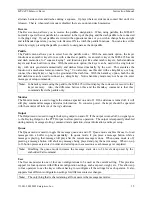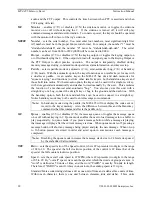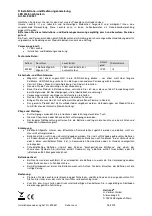
MFJ-495 Memory Keyer
Instruction Manual
©
2001-2009 MFJ Enterprises, Inc.
25
messages and status information. To conserve power, the keyer should be operated with the
monitor off in favor of the rig’s sidetone.
To change Monitor mode type “~M” followed by “Y’ for on, “N” for off, or ENTER to
toggle. The keyer will respond with “ON” or “OFF”. Press ESC or any other key to cancel
and exit. Also, press ALT+F5 to toggle monitor on/off.
N####
N
umber – sets the serial number. The serial number can be set from 0000 to 9999 (0000 will
be converted to 0001). Enter up to four digits to set the current serial number and press
ENTER to accept and exit, or press ESC to cancel and exit.
O#
O
utput – enables (#=Y) or disables (#=N) the keying output, or toggles the keying output on
or off without the #. If the output is turned off, no signal goes to the Keying Output or the
PTT Output to allow practice operation. The output is temporarily disabled during memory
message storing, command mode operation, status information, and keyer setup.
To change Output mode type “~O” followed by “Y’ for on, “N” for off, or ENTER to toggle.
The keyer will respond with “ON” or “OFF”. Press ESC or any other key to cancel and exit.
Alternately, press ALT+F6 to toggle output on/off.
P#
P
addle – selects paddle mode of automatic (#=A), semi-automatic (bug, #=S) or hand-key
(#=H) mode. With the automatic option, the keyer functions as an iambic keyer for use with
a dual-lever paddle. As an iambic keyer, the MFJ-495 has dot and dash memories for
"squeeze keying" and functions just like other iambic keyers, both standalone keyers and
those built into radios. With semi-auto, the keyer can be used with a single-lever key, with
dots generated automatically and dashes formed manually by the user. This emulates the
function of a mechanical semi-automatic "bug." You also may use this unit with a straight
key or a bug, connect the straight key or bug to the ground and the dash line. With the hand-
key option, both the dot and dash lines can be used to connect to a straight key. Notice hand-
key mode may not be used to enter messages or commands.
Note:
In hand-key mode using the paddle, the MFJ-495 will not display the code sent or
record to the keyer memory. Also, the difference between this and the Hand-key
command is that this command affects the paddle only.
Q#
Q
ueue – enables (#=Y) or disables (#=N) the message queue, or toggles the message queue
on or off without the #. Queue mode enables the user to load messages into a buffer to play
sequentially. In queue mode, if you press a message button while a message is playing, that
message will play after the current message is done. When queue mode is off, pressing a
message button will abort any message being played and play the new message. When on, up
to 16 button presses are stored in order and acted upon in succession as each message is
completed.
To change Queue mode type “~Q” followed by “Y” for on, “N” for off, or ENTER to toggle.
The keyer will respond with “ON” or “OFF”. Press ESC or any other key to cancel and exit.
Alternately, press ALT+F7 to toggle queue on/off.
Note:
Disabling the queue mode increases the message stack size to 24 levels deep used
by the embedded Call command.
R##
R
atio – sets the speed ratio of the Speed control, where ## represents two digits in the range
of 02 to 20. The speed at the full clockwise position of the control is ## times that of the
speed at the full counter-clockwise position.
















































